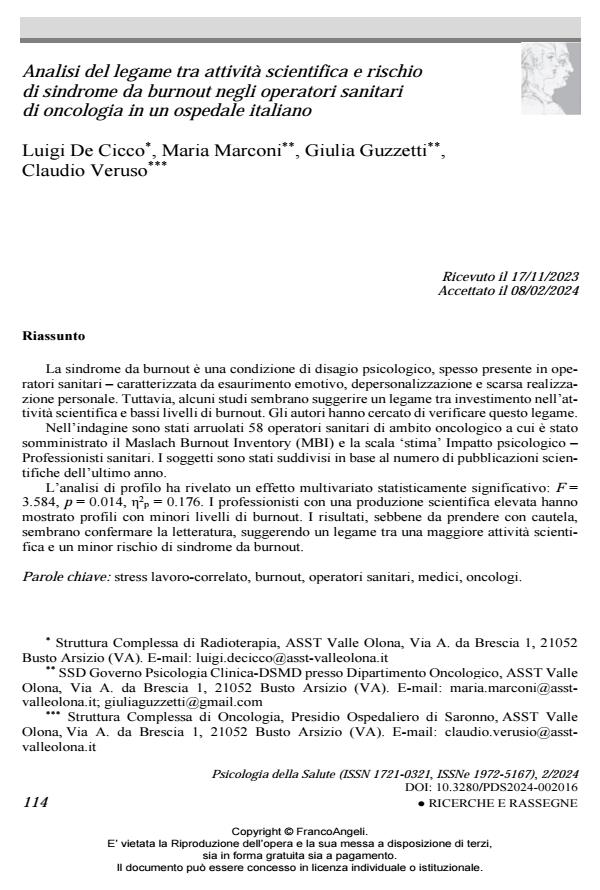Analisi del legame tra attività scientifica e rischio di sindrome da burnout negli operatori sanitari di oncologia in un ospedale italiano
Titolo Rivista PSICOLOGIA DELLA SALUTE
Autori/Curatori Luigi De Cicco, Maria Marconi, Giulia Guzzetti, Claudio Veruso
Anno di pubblicazione 2024 Fascicolo 2024/2
Lingua Italiano Numero pagine 17 P. 114-130 Dimensione file 348 KB
DOI 10.3280/PDS2024-002016
Il DOI è il codice a barre della proprietà intellettuale: per saperne di più
clicca qui
Qui sotto puoi vedere in anteprima la prima pagina di questo articolo.
Se questo articolo ti interessa, lo puoi acquistare (e scaricare in formato pdf) seguendo le facili indicazioni per acquistare il download credit. Acquista Download Credits per scaricare questo Articolo in formato PDF

FrancoAngeli è membro della Publishers International Linking Association, Inc (PILA)associazione indipendente e non profit per facilitare (attraverso i servizi tecnologici implementati da CrossRef.org) l’accesso degli studiosi ai contenuti digitali nelle pubblicazioni professionali e scientifiche
La sindrome da burnout è una condizione di disagio psicologico, spesso presente in opera-tori sanitari – caratterizzata da esaurimento emotivo, depersonalizzazione e scarsa realizzazione personale. Tuttavia, alcuni studi sembrano suggerire un legame tra investimento nell’attività scientifica e bassi livelli di burnout. Gli autori hanno cercato di verificare questo legame. Nell’indagine sono stati arruolati 58 operatori sanitari di ambito oncologico a cui è stato somministrato il Maslach Burnout Inventory (MBI) e la scala ‘stima’ Impatto psicologico - Professionisti sanitari. I soggetti sono stati suddivisi in base al numero di pubblicazioni scien-tifiche dell’ultimo anno. L’analisi di profilo ha rivelato un effetto multivariato statisticamente significativo: F = 3.584, p = 0.014, ?2p = 0.176. I professionisti con una produzione scientifica elevata hanno mostrato profili con minori livelli di burnout. I risultati, sebbene da prendere con cautela, sem-brano confermare la letteratura, suggerendo un legame tra una maggiore attività scientifica e un minor rischio di sindrome da burnout.�
Parole chiave:stress lavoro-correlato, burnout, operatori sanitari, medici, oncologi.
Luigi De Cicco, Maria Marconi, Giulia Guzzetti, Claudio Veruso, Analisi del legame tra attività scientifica e rischio di sindrome da burnout negli operatori sanitari di oncologia in un ospedale italiano in "PSICOLOGIA DELLA SALUTE" 2/2024, pp 114-130, DOI: 10.3280/PDS2024-002016